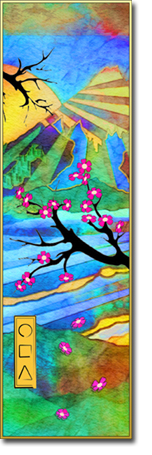On The Way: The Daily Zen Journal
“No Mind” is Buddha
Song-chul (1912-1993)

What exactly is this No Mind we are talking about? Let’s use a mirror as an analogy, since the mirror is often used in Buddhism when explaining fundamental Mind, fundamental nature, or original face.
Think of delusions as dust, and No Mind as the natural state of the mirror. That state—a spotless mirror—is Buddha nature, fundamental nature, original face. If you dust off the mirror, you have this natural state.
So this No Mind is not a state of emptiness, void, blankness, or vacuity. It is this state of complete elimination of all delusion, a state of perfect, quiet brilliance. Contrary to common misunderstanding, it is not a state of absolute thoughtlessness, like a boulder.
The Chinese characters are those for No Mind, but it is not a state of no mind, or blank mind. It is a state of no delusions, a mirror free of dust, the state where this brilliant light of wisdom pervades everything.
This No Mind can also be explained in terms of “non-producing, non-extinguishing.” Non-producing is the state without a trace of delusion, and non-extinguishing is the state of the great light of wisdom. Non-producing is the “tranquil” and non-extinguishing is the “light.”
In the Sutras, this state of Mind is referred to as correct, or proper wisdom. Correct, or proper refers to the state without delusion, and the wisdom refers to the great light. So Buddha is often described as maintaining wisdom at a fixed level. The achievement of the state is also called “seeing into one’s nature.” It is achieving both Buddhahood and nirvana at the same time.

Many people think of nirvana as a state which comes after death. But a state of nothingness after death is not nirvana. True nirvana is this state of completely delusionless tranquility in a brilliance of universal magnitude.
To think that the stillness that we are talking about exists without this brilliance is not Buddhism. And achievement of this state of tranquility and brilliance is what we mean by deliverance or release from suffering and delusion.
The Awakening of Faith sums this all up simply by saying that deliverance is release from all delusion and the reaching of the Great Light of Wisdom.

Based on what I have said, you now should be able to imagine what Buddhism is talking about when we use such terms as attaining Buddhahood, realizing Buddha nature, or achieving No Mind. Of course, to you this is still nothing but theory or speculation. But if you consider yourself a Buddhist, you have to try to experience this yourself. That is the very purpose of Buddhism. So you’re wondering if in fact you are capable of experiencing this.
Equality is basic to Buddhism, and we are all equal in that our basic nature is that of Buddha. So becoming a Buddha is not transformation out of the human state into another realm.
Let’s go back to the analogy of the spotless mirror—it reflects everything in a bright light. This bright light is the still Mind, it is the Tranquil Brilliance, it is maintaining wisdom at a fixed level, and it is non-producing and non-extinguishing.

Then why are we humans like a damaged mirror, incapable of reflecting this brilliance? If our basic nature is pure and clear and brilliant, then why are we in this human state of pain and suffering? Not because the mirror is damaged, but because our Mind is covered with dust.
If we wish to reflect this Great Light, this still Mind, there is no need to make ourselves over into another mirror. All we have to do is to discover the mirror within us and wipe away the dust to find our true selves.
Song-chol (1912-1993)
Excerpted from Echoes from Mt. Kaya: Selections on Korean Buddhism – out of print




While the mirror is a familiar image used in Zen, the Platform Sutra by Hui-neng is the most famous illustration of how widely differently this idea can be taken.
Recall the story of the Fifth Patriarch of Zen, Hung-jen, who asked the monks to compose a gatha representing their understanding of the Dharma. The task was set to determine who would inherit the robe and bowl and be appointed the Sixth Patriarch.
Since the monks felt like the head monk would surely be the one to move into that position, no one bothered to submit a gatha. The senior monk wrote his poem on the wall of the corridor without signing it at midnight:
“The body is a bodhi tree
the mind is like a standing mirror
always try to keep it clean
don’t let it gather dust”
The Fifth Patriarch’s response to him was “This gatha of yours shows your understanding has only reached the threshold and has not yet entered inside. If ordinary people use your gatha in their practice, they won’t regress. But someone with such an understanding who seeks perfect enlightenment will never realize it.
If you want to enter the door, you have to see your nature. Go back and think about this for a few days and write me another gatha. If you’re able to enter the door and see your nature, I will give you the robe and the Dharma.”
Hui-neng worked in the millroom at the time and was thought to have no potential at realization. However, once he heard the above gatha, he knew the person who wrote it had not realized Mind. He had one of the novices write his gatha on the wall since he was illiterate:
“The mind is the bodhi tree
the body is the mirror’s stand
the mirror itself is so clean
dust has no place to land.”
He was called to Hung-jen’s room at midnight and inherited the bowl and robe and left the monastery.
There is a place in practice for both these gathas. They symbolize gradual cultivation and sudden enlightenment and can co-exist quite effortlessly. Due to the variation in abilities, they represent a teaching for everyone. It doesn’t have to be an either/or situation. We can co-exist with both and respect the practice of both approaches.
Gradual cultivation is what we practice even if we have a great realization, there is still the habit force that will attempt to steer us away. The wiping of the mirror represents the return to center.
Sharing the teaching of the mirror with you,
Elana, Scribe for Daily Zen